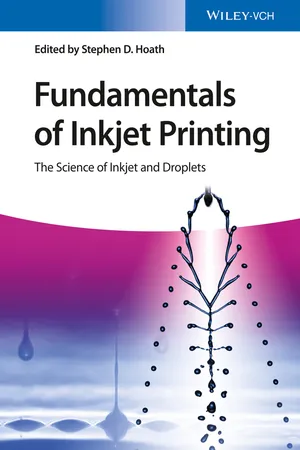
Fundamentals of Inkjet Printing
The Science of Inkjet and Droplets
- English
- ePUB (mobile friendly)
- Available on iOS & Android
About This Book
From droplet formation to final applications, this practical book presents the subject in a comprehensive and clear form, using only content derived from the latest published results.
Starting at the very beginning, the topic of fluid mechanics is explained, allowing for a suitable regime for printing inks to subsequently be selected. There then follows a discussion on different print-head types and how to form droplets, covering the behavior of droplets in flight and upon impact with the substrate, as well as the droplet's wetting and drying behavior at the substrate. Commonly observed effects, such as the coffee ring effect, are included as well as printing in the third dimension. The book concludes with a look at what the future holds. As a unique feature, worked examples both at the practical and simulation level, as well as case studies are included.
As a result, students and engineers in R&D will come to fully understand the complete process of inkjet printing.
Frequently asked questions
Information
Chapter 1
Introductory Remarks
1.1 Introduction
| Small office and home | Commercial print | Decorative products | Packaging | General industrial | Textiles | |
| Already widely used | Home printers, local office printers/copiers | Billing and ticketing, graphic displays, point-of-purchase | Signage, banners, stickers, ceramic tiles | Coding and marking | T-shirts | |
| Starting to be used | Books, brochures, flyers, newspapers, magazines | Wallpaper | Labels: self-adhesive, shrink, and so on | Displays, dashboards, plastic cards, 3D printing | “Designer” fabrics, ties, scarves | |
| Medium-term target | Flooring, décor (e.g., melamine) | Corrugated board, cartons, cans, glass bottles | Printed circuit boards, electronic devices | Soft furnishings, other clothing | ||
| Not a current target | Banknotes, security printing | Flexible packaging, molded tubs, bottles | Toys, other durables | Carpets, rugs |
Table of contents
- Cover
- Title Page
- Copyright
- Table of Contents
- List of Contributors
- Preface
- Chapter 1: Introductory Remarks
- Chapter 2: Fluid Mechanics for Inkjet Printing
- Chapter 3: Inkjet Printheads
- Chapter 4: Drop Formation in Inkjet Printing
- Chapter 5: Polymers in Inkjet Printing
- Chapter 6: Colloid Particles in Ink Formulations
- Chapter 7: Jetting Simulations
- Chapter 8: Drops on Substrates
- Chapter 9: Coalescence and Line Formation
- Chapter 10: Droplets Drying on Surfaces
- Chapter 11: Simulation of Drops on Surfaces
- Chapter 12: Visualization and Measurement
- Chapter 13: Inkjet Fluid Characterization
- Chapter 14: Surface Characterization
- Chapter 15: Applications in Inkjet Printing
- Chapter 16: Inkjet Technology: What Next?
- Index
- End User License Agreement